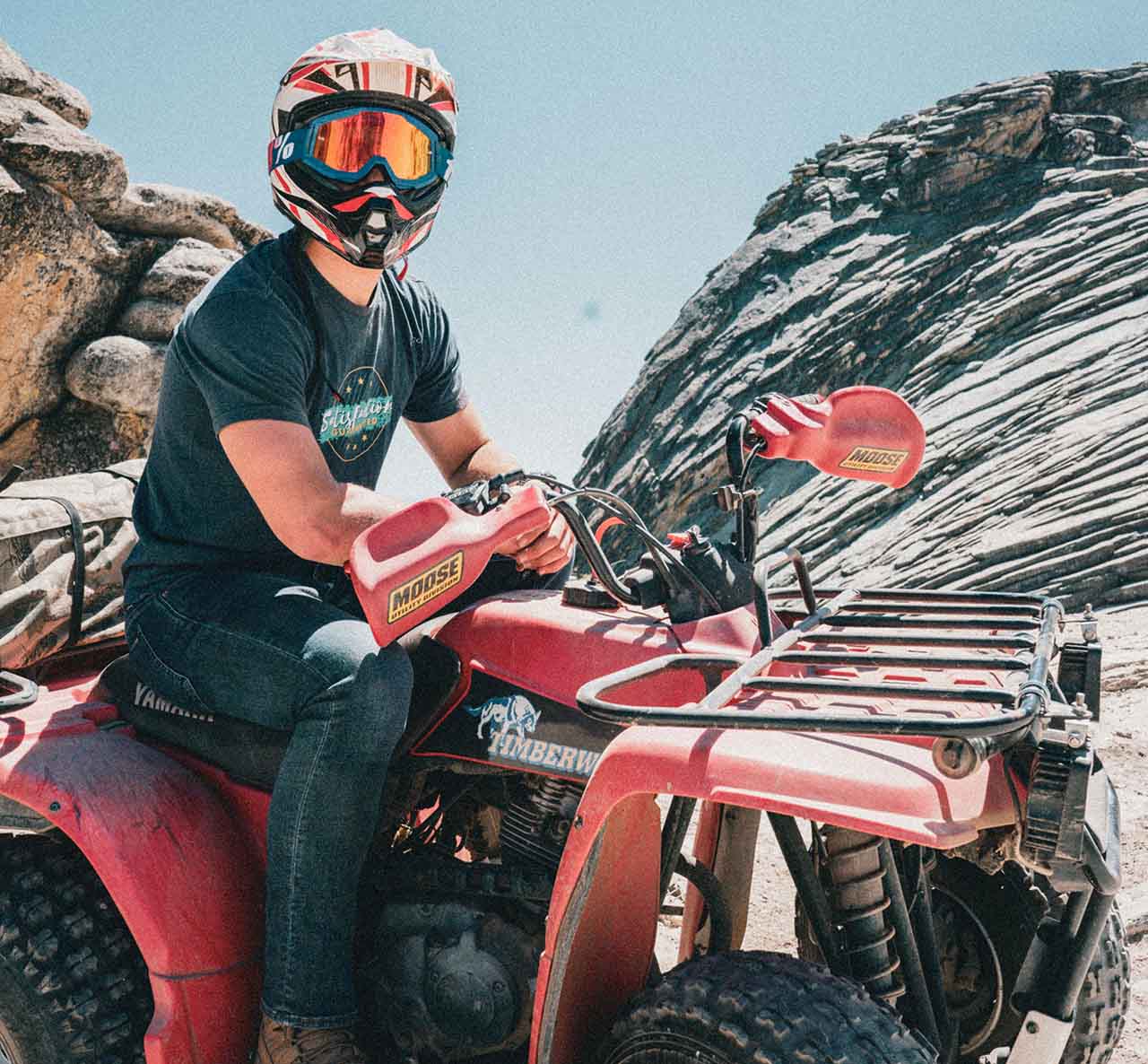Are you looking to ensure maximum protection while riding your ATV? Learn how to choose the right ATV helmet for protection. This guide covers essentials like fit, safety ratings, and the latest protective technologies to help you make an informed choice.
Key Takeaways
- ATV helmet safety depends on achieving a proper fit, involving precise head measurements, checking for pressure points, and ensuring snugness without discomfort.
- Understanding safety ratings like DOT, SNELL, and ECE is crucial, as these certifications indicate a helmet’s tested ability to protect against impacts and environmental conditions.
- Advanced features in ATV helmets, such as MIPS technology, emergency release systems, and built-in communication tools, enhance protection and improve the overall riding experience.

The Essential Guide to ATV Helmet Fit
The proper fit of a helmet is critical to rider safety. A helmet that’s too loose may detach in an accident, while a too-tight helmet can cause discomfort and distract the rider. Achieving the right fit ensures both protection and comfort.
Measuring Your Head
Start by taking precise measurements of your head. Use a flexible measuring tape to circle the widest part of your head, passing just above the eyebrows and ears. Consistent, accurate measurements are essential for finding a helmet that fits properly.
Checking for the Right Fit
With your measurements in hand, choose a helmet that offers a snug fit. Pay attention to any pressure points, especially near the temples and forehead. The ideal helmet should provide comfort without causing discomfort, striking a balance between security and wearability.
The Perfect Snugness
The helmet should hug your cheeks without compressing them too tightly. Ensure that no fingers can slip between your forehead and the helmet. If you feel any pressure points, adjust the padding to achieve a comfortable fit.
Decoding Safety Ratings: What They Mean for ATV Riders
Safety certifications are more than just labels. They indicate a helmet’s ability to protect you in an accident. Understanding these ratings helps you make an informed choice.
Understanding DOT Certification
A DOT-certified helmet has undergone rigorous evaluations, including impact resistance, penetration tests, and retention system assessments. This certification ensures the helmet can withstand collisions and remain securely fastened during an accident.
SNELL Standards Explained
SNELL-certified helmets are subjected to stringent tests, including various impact evaluations and chin strap assessments. This certification is ideal for competitive ATV racers who need helmets that meet the highest safety standards.
ECE Certification: The Global Benchmark
Helmets with ECE 22.05 certification are recognized globally for their safety. They undergo rigorous tests for impact absorption, chin strap functionality, and noise regulation, ensuring both protection and comfort.
Advanced Features for Enhanced Protection
Modern ATV helmets come with advanced features that provide superior protection and enhance the riding experience.
MIPS Technology: The Next Level of Protection
The Multi-Directional Impact Protection System (MIPS) includes a low-friction layer that helps reduce rotational forces during angled impacts, offering enhanced protection for your brain.
Emergency Release Systems
Emergency release systems allow responders to remove your helmet quickly and safely in an accident, reducing the risk of further injury.
Built-in Communication Tools
Integrated communication systems, such as Bluetooth intercoms, allow you to stay in touch with fellow riders, improving coordination and safety.
Tailored Recommendations for Every Ride
Different riding activities require different types of helmets. Whether you’re a casual trail rider, a competitive racer, or using your ATV for work, there’s a helmet tailored to your needs.
Casual Trail Riding Picks
For recreational riders, comfort is key. Choose a lightweight helmet with washable liners and the option to add gadgets like cameras for an enhanced riding experience.
Competitive Racing Selections
Racers need helmets that meet SNELL standards, offer excellent airflow, and provide superior protection at high speeds.
Utility Workhorse Helmets
For utility tasks, select a helmet that combines robust protection with practical features like ventilation and detachable mouthpieces. These helmets are designed to withstand the rigors of farm or utility work.
MRC Helmet Replacement Face Shield: A Critical Add-On
An MRC Helmet Replacement Face Shield enhances visibility and protection from debris and weather conditions, making it a valuable accessory for any ATV rider.
Maintaining Your Helmet: Longevity and Care Tips
A helmet is a vital piece of safety gear that requires regular maintenance to ensure it remains effective.
Cleaning Your Helmet
Use a soft cloth or sponge with mild soap and lukewarm water to clean the exterior of your helmet. For removable liners, wash them with baby shampoo and let them air dry.
Proper Storage Practices
Store your helmet in a cool, dry place away from direct sunlight and extreme temperatures. Using a protective case or helmet bag helps maintain its condition.
Knowing When to Replace
Replace your helmet every three to five years or immediately after a significant impact to ensure its protective qualities remain intact.
Final Thoughts
Choosing the right ATV helmet is as crucial as selecting your ATV itself. The right helmet offers protection, comfort, and advanced features to enhance your riding experience. With proper care, your helmet will be a reliable companion on all your adventures. Ride safely and enjoy the journey.
Frequently Asked Questions
How do I know if my ATV helmet fits correctly?
Your ATV helmet should fit snugly without causing discomfort or pressure points. It should remain stable when you move your head and not shift around.
What’s the difference between DOT, SNELL, and ECE helmet certifications?
DOT is a U.S. standard, SNELL is a voluntary standard with rigorous testing often used for racing, and ECE is a comprehensive European standard recognized globally.
Why is MIPS technology important in an ATV helmet?
MIPS technology helps reduce rotational forces during angled impacts, offering enhanced protection against brain injuries.
